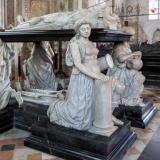The Mystery of The Missing Foot
This morning the following letter fell out of a book as I took it from the shelf. I had never seen the letter before. It was dated 19th February 1943, and was from the 6th Lord Hotham at Dalton Hall to Mrs Arundell Esdaile.
"Thank you for your letter. The skeleton was for many years kept in a coffin-like box in a stable loft, but when the stables and most of the house were requisitioned by the Army it was moved to the Estate Yard; unfortunately in the move a foot was broken & we have been unable to find it – I suppose some predatory soldier kept it as a curious memento. I imagine that it would be quite easy to have another foot made though I see no need to do so as I feel there might be an outcry in the parish if the skeleton were replaced after an interval of so many years & I do not therefore propose to replace it."
The recipient of the letter was Katharine Esdaile, then the leading authority on post-medieval church monuments, and the skeleton was one that now lies below the figure of Sir John Hotham, 2nd baronet (died 1689) on his splendid monument in South Dalton church. Sir John was only twelve when his father and grandfather were executed by the Parliamentarians for their supposed collusion with the Royalists in the early years of the Civil Wars. An opponent of Charles II’s pro-French and pro-Catholic sympathies Sir John Hotham went into exile in Holland in 1684, only returning with William of Orange. Hotham landed with the future king at Brixham on 5 November 1688. He was soon after appointed Governor of Hull, and on his return to the East Riding in February 1689 he was greeted by a crowd of 10,000 at Hull. They escorted him in triumph to Beverley. The day was wet and cold and Sir John, who rode bareheaded, caught a ‘violent and alarming cold’ from which he never recovered. He died on 6 April 1689 and was buried at South Dalton. His monument was made and erected after the death of his widow, Elizabeth, in December 1697. Her will made provision for a tomb to be placed in South Dalton Church to her late husband ‘like unto the Old Cecil Tomb att Hatfield in Hartfordshire’. (Hull History Centre, U DDHO/74/13).
Sir John Hotham’s tomb is very similar to that to Robert Cecil, although in a more Baroque style. Four kneeling virtues of white marble, Truth with a mirror, Fortitude with a broken column, Justice with a sword, and Temperance with a water pitcher, support a black marble slab. The figure of Sir John in armour lies on the slab, and underneath is a marble skeleton with most of its right foot missing. It has been suggested that the sculptor of the South Dalton tomb was Caius G Cibber who was ‘sculptor in ordinary’ to king William III, but Cibber died in 1700, and he probably would not have had the time to complete the work.
A photograph in A.M.W. Stirling, The Hothams (1918), shows the monument without the skeleton. It must have been thought distasteful, or too macabre, so it was taken away and hidden in a box in the stable loft. The skeleton was there when seen by a writer of an article in the Beverley Independent in 1888, but it had gone by 1906 when J.E. Morris in his Little Guide to the East Riding of 1906, wrote: ‘It is difficult to get a near inspection of this monument, but the writer is inclined to believe that the “extended skeleton” has been judiciously removed’. The date when it was returned has yet to be discovered, but probably after the death of the 6th Lord Hotham in 1967.
David Neave 22 March 2021.
St Mary's Church, South Dalton, East Yorkshire
The church of St Mary was designed by John Loughborough Pearson and built 1858-61 as a replacement for a brick structure. Its spire is over 200 feet (61 m) tall. Inside the church lie a number of the Hotham family; the older monuments were transferred from the earlier church. There is a fine black and white marble monument in ... (read more...)

 Tomb of Robert Cecil, 1st Earl of Salisbury (died 1612), Hatfield, by Maximillian Colt, the King’s Master Sculptor, who designed the tomb of Elizabeth I in Westminster Abbey
Tomb of Robert Cecil, 1st Earl of Salisbury (died 1612), Hatfield, by Maximillian Colt, the King’s Master Sculptor, who designed the tomb of Elizabeth I in Westminster Abbey 

